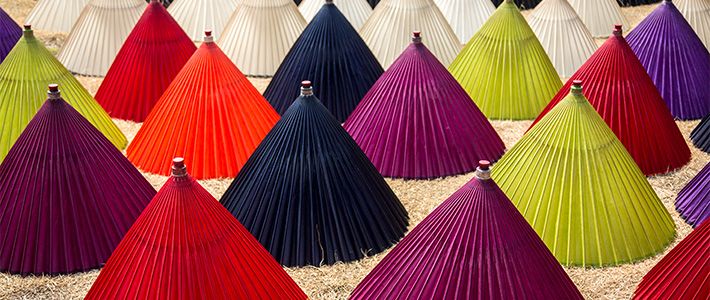
“Cool Traditions” Stay in Tune with Modern Life
Under the Eye of the Snake: Beautiful, Durable Umbrellas Made of Mino “Washi”
Culture- English
- 日本語
- 简体字
- 繁體字
- Français
- Español
- العربية
- Русский
Umbrellas Made of Paper and Bamboo
The Ja-no-me-gasa (snake’s eye umbrella) makes a famous appearance in the children’s song Ame-furi (It’s raining), with lyrics by the poet Kitahara Hakushū. These stylish umbrellas, made from bamboo and washi paper, were a common part of daily life in Japan until the early decades of the twentieth century, protecting generations of Japanese people from the rain and sun.
Ame ame fure fure
Kā-san ga
Ja-no-me de o-mukae
Ureshii na
Rain, rain—I don’t care
Here comes mother to meet me with a ja-no-me
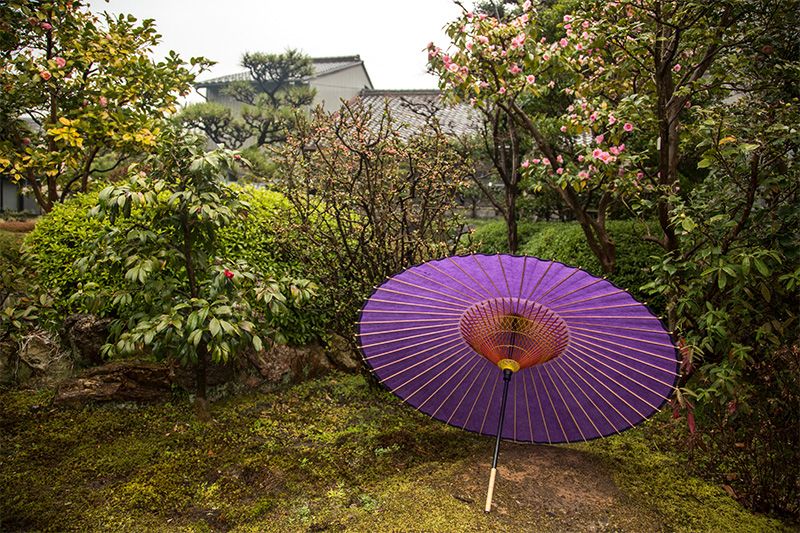 Ja-no-me-gasa can be used as both umbrellas and parasols. The colorful threads stitched into the framework are not just for decoration, but also help to strengthen the frame and make the umbrella sturdier.
Ja-no-me-gasa can be used as both umbrellas and parasols. The colorful threads stitched into the framework are not just for decoration, but also help to strengthen the frame and make the umbrella sturdier.
It is the pattern painted on the canopy of the umbrella that gives it its surprising name, which might seem inappropriate for such an attractive piece of craftsmanship. The motif features a bold, white line that forms a circle against a vivid background of red, blue, or purple. People thought the circle looked like a large eye. But why a snake’s eye? In previous times, snakes were regarded as messengers of the gods, and it was believed that the snake’s eye motif had the power to ward off bad luck and evil spirits. As well as shielding the user from the elements, therefore, the ja-no-me-gasa also protected people from misfortune. Despite its slightly unsettling name, the snake’s eye umbrella was a beloved and essential part of everyday life for generations.
Seen from afar, it is the colors and motif that catch the eye. But when you hold one in your hand, it is the intricate design that is likely to fascinate. From the tip, dozens of bamboo spokes run radially in straight lines. Finely stitched around these are colorful strands of decorative thread. The washi paper lets through a delicate light. When it rains, there is a soft, pattering sound as the raindrops bounce off the oiled coated surface of the umbrella. The umbrella can easily be opened and closed, and on windy days, or when passing by someone coming the other way down a narrow street alleyway, the umbrella collapses easily to allow people to pass.
A Visit to Gifu’s Traditional Umbrella-Makers
The Kanō district in Gifu City has been producing umbrellas since the middle of the eighteenth century. Taking advantage of its proximity to local workshops producing the robust, fine-quality Mino washi paper, the umbrella-making tradition continues to this day. The bamboo frame is bound with cotton threads, and a canopy of washi paper stretched over the frame, and then waterproofed with perilla oil. Making an umbrella is an amalgam of intricate craft processes and involves more than 100 individual procedures.
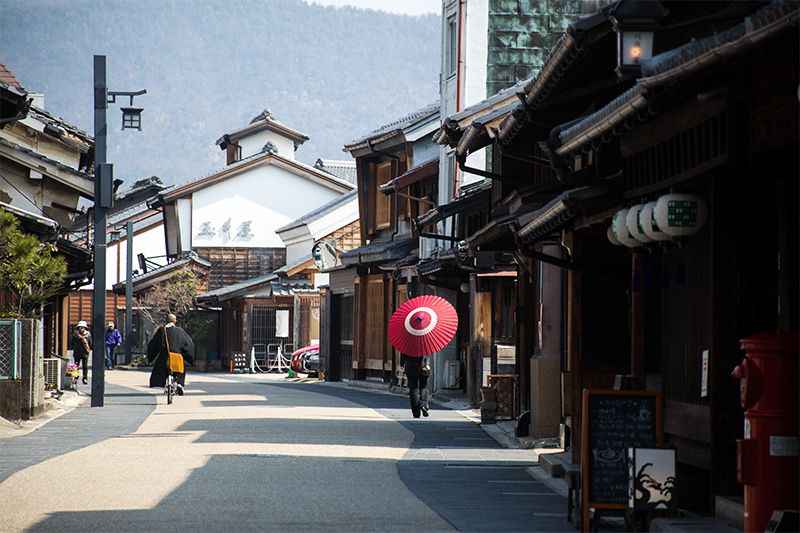 The distinctive silhouette of a ja-no-me-gasa adds an evocative element to the old streets of Gifu, a former castle town. The white circle is the “snake’s eye” that gave the umbrella its name.
The distinctive silhouette of a ja-no-me-gasa adds an evocative element to the old streets of Gifu, a former castle town. The white circle is the “snake’s eye” that gave the umbrella its name.
There are five main stages: making the frame, producing the small spindles (rokuro) that form the mechanism used to open and shut the umbrella, assembling these parts together, attaching the paper canopy, and finishing. Making an umbrella is a collaborative process, with each procedure performed by specialists. The work-in-progress is passed from one artisan to the next.
“Our umbrellas have an elegant and pleasant appearance. The aim is to get the ribs of the framework as thin as possible. You need to make sure that the washi paper is as thin as possible without losing its strength,” says Sakaida Eiji, owner of a traditional umbrella business in Kanō.
“The bamboo we use for the framework is pliable and strong enough to withstand wind and rain, and doesn’t bend even when it is cut thin. Back in the old days, they used to recycle them from old umbrellas, and some small businesses used to specialize in old bamboo spokes.”
But even after being coated with protective oil, the washi umbrella will eventually tear and break after it is used for a long period, and insects will wreak damage on the paper if the umbrella is kept in storage. When this happens, the umbrella can be given a new lease on life by reapplying a new canopy. So long as the bamboo framework is still sturdy, the umbrella will continue to give good service for a lifetime.
How Umbrellas Are Made
Even in Gifu, home of the traditional Japanese umbrella, only a few people are left today with the skills to make the bamboo frame. We watched one octogenarian craftsman at work, in a workshop redolent with the fresh smell of new bamboo.
The worker first peels the bark from the bamboo and strips away the knobby nodes. It is a job that involves lots of cutting and paring away. A cylinder of bamboo roughly 27cm in girth provides enough bamboo to make 100 ribs 3 millimeters in width. This is enough for two ja-no-me umbrellas. When these umbrellas are closed, the washi paper is folded onto the inside—unlike most umbrellas today. The ideal is for the finished umbrella to take on the shape of the original bamboo cylinder when closed. To achieve this, the workers need to reassemble the 100 bamboo ribs in their original order.
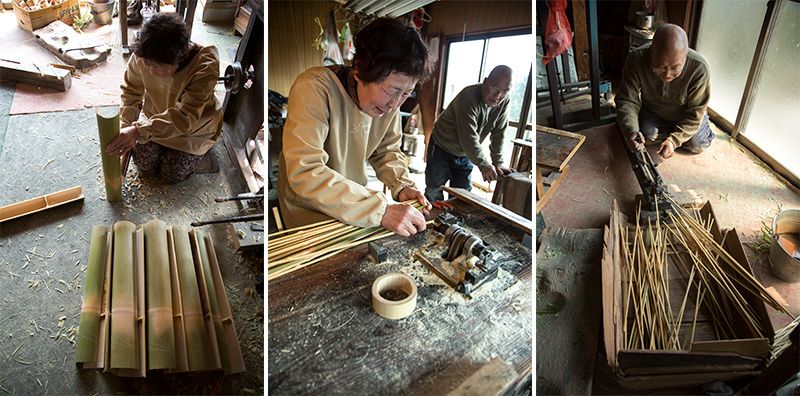 Making the ribs and spokes that will form the umbrella’s frame. Smoothing down the nodes on the inside of the bamboo (left). Using a billhook, the worker splits the bamboo into rods approximately three millimeters wide, and makes a hole for the thread to pass through the node of the bamboo (center). Shaving down the rods to make them thinner (right).
Making the ribs and spokes that will form the umbrella’s frame. Smoothing down the nodes on the inside of the bamboo (left). Using a billhook, the worker splits the bamboo into rods approximately three millimeters wide, and makes a hole for the thread to pass through the node of the bamboo (center). Shaving down the rods to make them thinner (right).
It’s enough to make the mind reel. How do they do it? Apparently there is a secret technique. I watch closely the worker closely as her hands work on the bamboo. Before cutting the bamboo, she scratches a line on the inside of the bamboo with a nail. Now all she needs to do is reassemble the cut strands so that this line re-forms, and the umbrella will take on the same shape as the original cylinder of bamboo. Once the ribs have been strung in order onto a thin rod of bamboo, the work-in-progress is delivered to another team of workers.
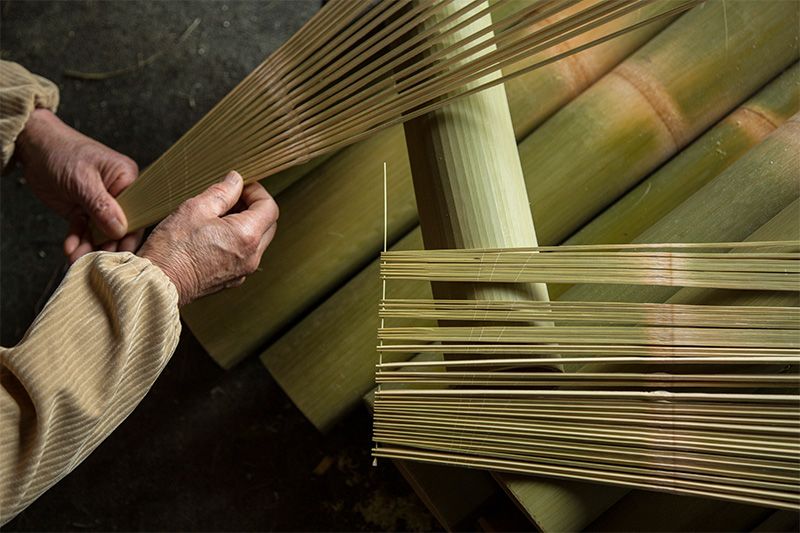 Using a line scratched onto the inside of the bamboo as a guide, the pieces are reassembled in their original order. The ribs are strung onto a thin strand of bamboo and dried in the sun before being moved onto the next stage.
Using a line scratched onto the inside of the bamboo as a guide, the pieces are reassembled in their original order. The ribs are strung onto a thin strand of bamboo and dried in the sun before being moved onto the next stage.
Next, the main ribs of the umbrella are joined to the supporting spreader struts and the umbrella begins to take shape. The most important parts of the umbrella are two wooden spindles called rokuro. The atama-rokuro at the tip of the umbrella holds the main ribs of the umbrella, while the temoto-rokuro slider spindle located on the central shank of the umbrella holds the supporting struts stretchers. The worker skillfully attaches the supporting spreader struts to the ribs of the umbrella with cotton thread. The joins between the rokuro spindles and the rods are like the joints of the umbrella. It is these that enable the umbrella to open and shut cleanly and smoothly. It is remarkable that this simple frame made of bamboo bound with cotton makes for an umbrella capable of withstanding rough handling of ordinary use.
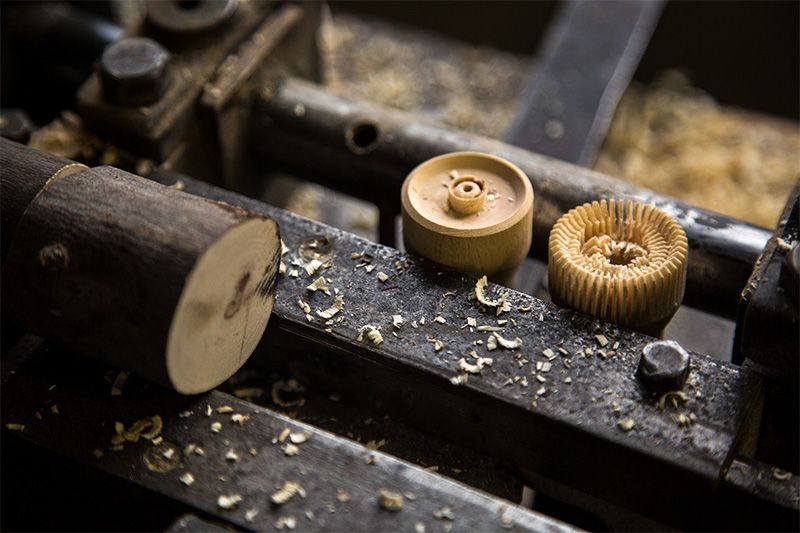 These spindles, made from the Japanese snowbell (Styrax japonicas), form the central hinges of the traditional umbrella.
These spindles, made from the Japanese snowbell (Styrax japonicas), form the central hinges of the traditional umbrella.
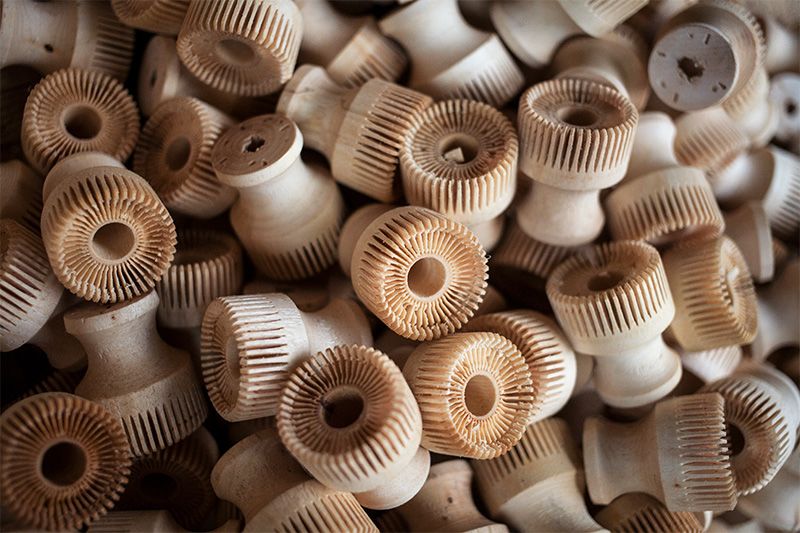 Each umbrella uses two spindles—a fixed spindle at the top of the umbrella, and a sliding spindle that is used to open and close the umbrella.
Each umbrella uses two spindles—a fixed spindle at the top of the umbrella, and a sliding spindle that is used to open and close the umbrella.
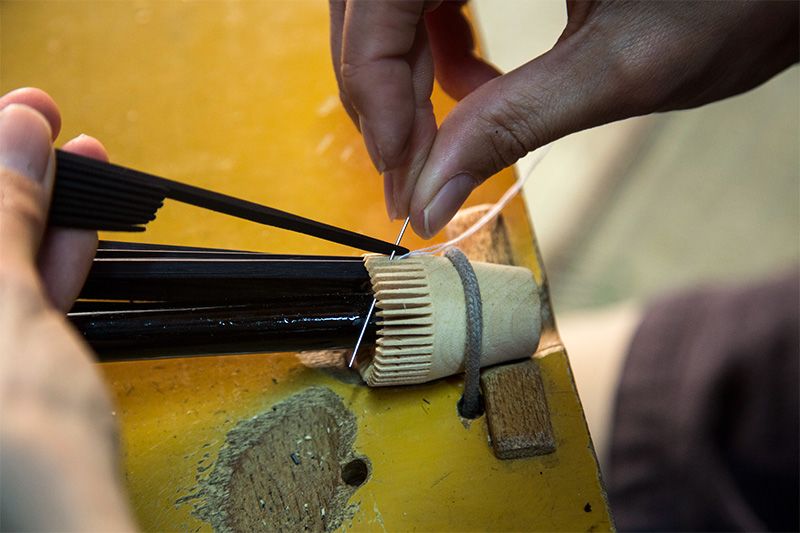 Attaching the fixed spindle to the ribs of the umbrella with cotton thread requires a steady hand.
Attaching the fixed spindle to the ribs of the umbrella with cotton thread requires a steady hand.
Once the basic umbrella has taken form, the next stage is to apply the washi paper canopy—another task performed by specialists. The workspace retains an atmosphere evocative of vanished days, and time seems to pass more slowly. The worker’s hands move rhythmically, and as the washi paper is stretched onto the frame, a vividly colored flower takes shape. “It’s hard to tell when you’re applying the paper,” one worker says, “but if it’s even a little bit crooked, the finished umbrella won’t fold properly.”
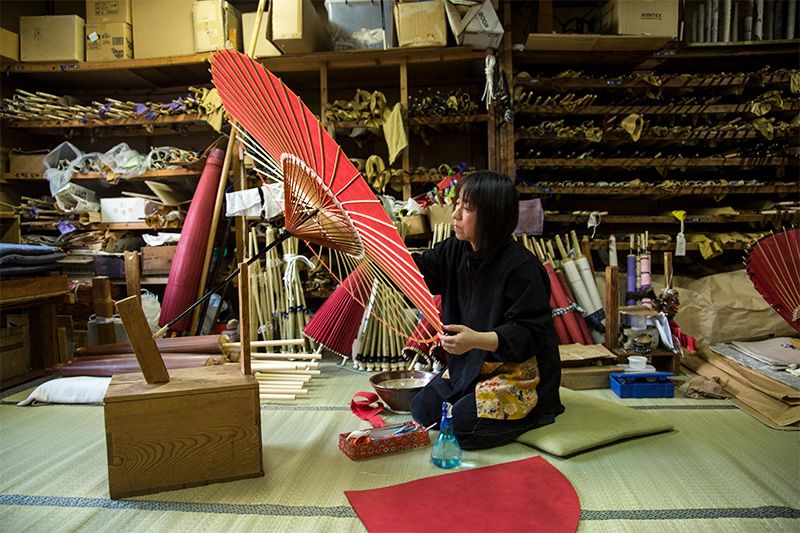 Attaching the paper. The ribs of the umbrella’s framework are fully opened and the strips of paper attached. Washi is also used to strengthen weak points in the frame, such as the joins between the ribs and the spokes and around the sliding spindle used to open and close the umbrella.
Attaching the paper. The ribs of the umbrella’s framework are fully opened and the strips of paper attached. Washi is also used to strengthen weak points in the frame, such as the joins between the ribs and the spokes and around the sliding spindle used to open and close the umbrella.
Getting the washi absolutely straight is not easy, since the paper has to be folded in under the inside of the framework. I speak to one young worker who says her relationship with the ja-no-me-gasa was one of love at first sight. Has that infatuation endured, I ask. “Fifteen years on, there’s still so much to learn I haven’t had time to get tired of it.” For a moment, her silently moving hands fall still and she looks up at me with a smile. Her beaming face seems to suggest that the future of the ja-no-me umbrella is in good hands.
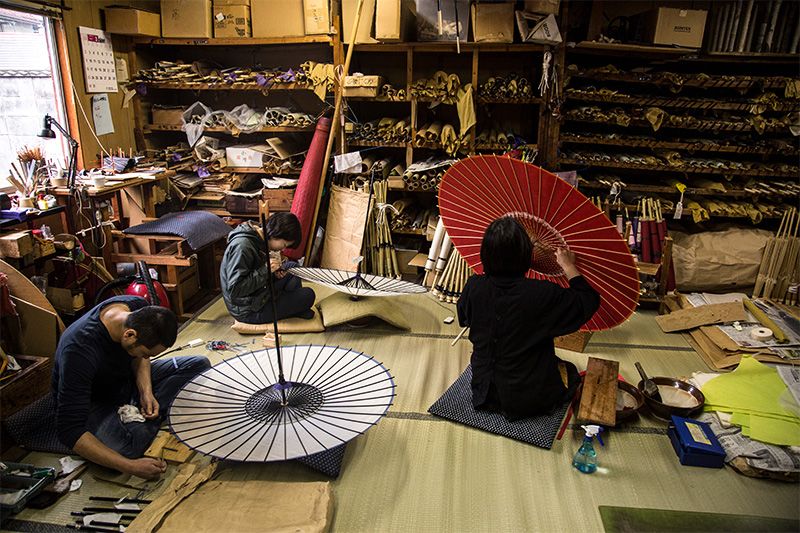 Young people work on improving their skills at a workshop of Sakaida Eikichi Honten. Many young people are attracted to the idea of learning a traditional craft.
Young people work on improving their skills at a workshop of Sakaida Eikichi Honten. Many young people are attracted to the idea of learning a traditional craft.
(Originally published in Japanese on November 21, 2017. Interview and text by Mutsuta Yukie. Photos by Ōhashi Hiroshi. Banner photo: Various colored ja-no-me umbrellas left out to dry in the sun. The umbrellas are coated with oil first to make them waterproof. It normally takes two days in the summer to dry and three in the winter. Once the umbrellas are completely dry, lacquer is painted onto the framework.)